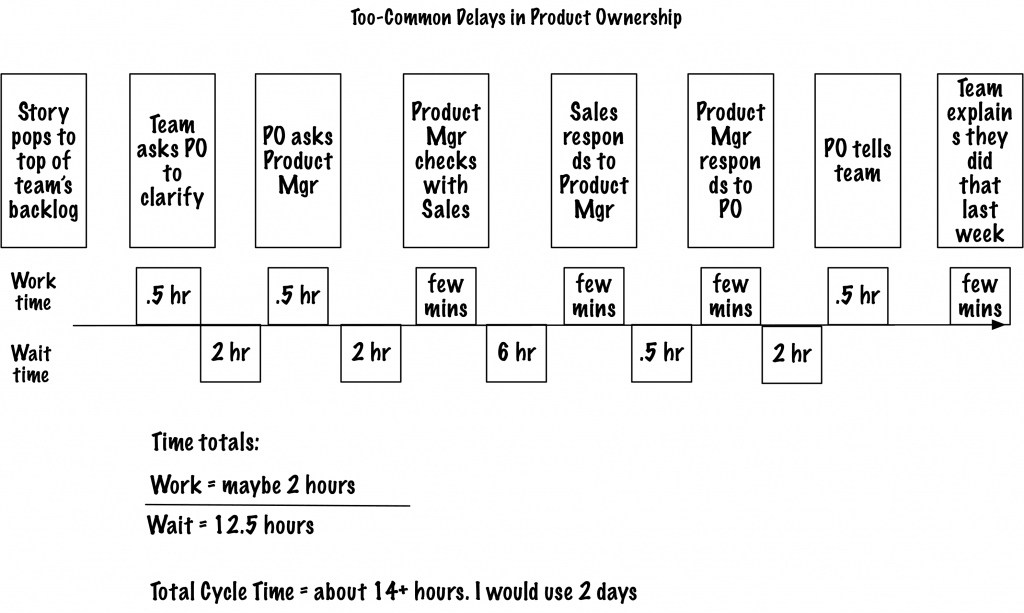Product Roles, Part 6: Shorten Feedback Loops
I started this series discussing the issue of the various product-based roles in an agile organization. I suggested a product value team because one person becomes a bottleneck. One person is unlikely to shepherd the strategy and the tactics for a product. And, batching the product planning in one-quarter chunks doesn’t encourage us to reduce the feedback loop duration. When we optimize for shortening feedback loops, we can create more experiments and have more options for the product.
Can Your Customer Be Your Product Owner?
Back when we started using agile approaches, many teams worked directly with their customers. If you’re in an IT organization and your customer is down the hall—literally down the hall—you might be able to use a customer as a product owner.
I say might, because, in my experience, the customer is too busy doing their work to be your product owner.
If you can use your customer as your product owner (which was the original idea), that might be the shortest feedback loop you can create.
- The customer and team work together to define the next little batch of work. (Little, as in small, as in maybe a few days of work. Think small.)
- The team works together, checking with the customer as necessary to clarify, to show, to verify with examples, that they are delivering this small chunk of work.
- The customer has ample opportunity to say, “yay!” or “nay,” at any point through this work.
- The team delivers the work to the customer
If you can build for your customer on a daily basis, release to your customer on a daily basis, keep doing what you’re doing.
However, if the customer-as-product-owner doesn’t have the time to spend with the team, you have the worst of all worlds: someone who has the title of product owner and doesn’t do it. Your feedback loops become long.
And, what if you create a mass-market product? You can’t bring all of us into your office. You don’t want to. We don’t know what we need. This is why the product value team connects the product strategy to the corporate strategy.
When teams see their feedback loops, and when the organization sees the duration of everything they’re doing, they often rethink the way they’re managing the product owner role.
Visualize Your Current Feedback Loops
Here’s a value stream map for the Seeing the Close-to-the-Customer Conundrum post:

This team is not close enough to the product owner. The product owner isn’t close enough to the product manager. The product manager isn’t close enough to the salespeople, and the process repeats itself coming back the other way.
Too many people are bottlenecks. Somehow, these people don’t think they need to collaborate to clarify requirements and keep the team moving.
These folks are so busy with “their” work, they lost the reason we use agile approaches at all.
Agile Approaches Invite Collaboration and Frequent Delivery
Let’s remember why we use agile approaches:
- We want to collaborate as a team so we finish the work in as short a time period as possible. (No handoffs or delays or waiting for finishing.)
- We want to collaborate with the customer to deliver value in a reasonable period of time.
- Based on our collaboration, we can then change what we originally planned to do something more valuable instead.
When we collaborate as a team and with customers, we have the shortest possible feedback loops. We can then change to the next valuable possibility.
Agile approaches are not about “doing more with less” or some such nonsense. Sure, that’s what managers want, but that’s not what an agile approach offers.
Agile approaches offer us:
- The possibility to not do less-valuable work. We “gain” time by not doing some work.
- When we collaborate, we “gain” time by spending less time waiting for other people.
- The opportunity to change more valuable work faster.
When we separate the “product people” from each other, we lose all those advantages. Even if we have cross-functional collaborative “product” or “feature” teams, we lose the help of the product people.
Product Value Teams Can Help Shorten Feedback Loops
In the cycle time map above, we might need a product value team with more people: salespeople, the product manager, the various product owners.
How many people do you need to answer your product questions?
If you only need the product owner and product manager, you need a small product value team. However, if you need more than two people, you might need a different structure or a different way to manage the inevitable questions.
How can you shorten the feedback loop between asking a product question and receiving the answer? That’s your structure for your product value team.
The series:
- Product Roles, Part 1: Product Managers, Product Owners, Business Analysts
- Product Roles, Part 2: The Product Value Team
- Product Roles, Part 3: Product or Feature Teams
- Product Roles, Part 4: Product Orientation and the Role of Projects
- Product Roles, Part 5: Component Teams to Create Slices
- Product Roles, Part 6: Shorten Feedback Loops
Published on Java Code Geeks with permission by Johanna Rothman , partner at our JCG program. See the original article here: Product Roles, Part 6: Shorten Feedback Loops Opinions expressed by Java Code Geeks contributors are their own. |


